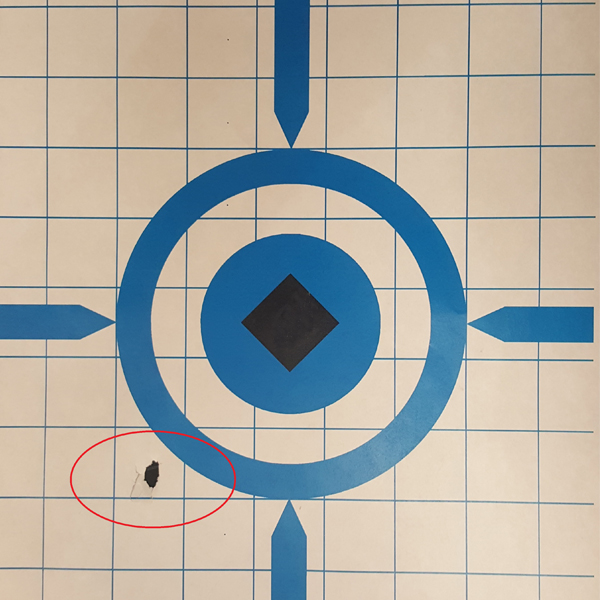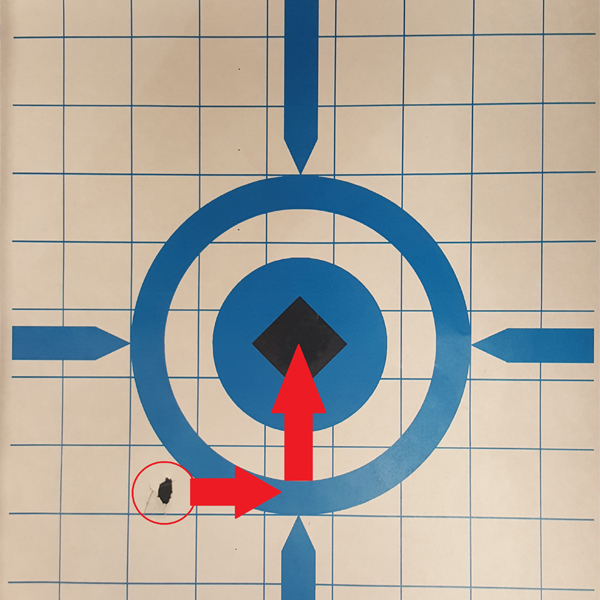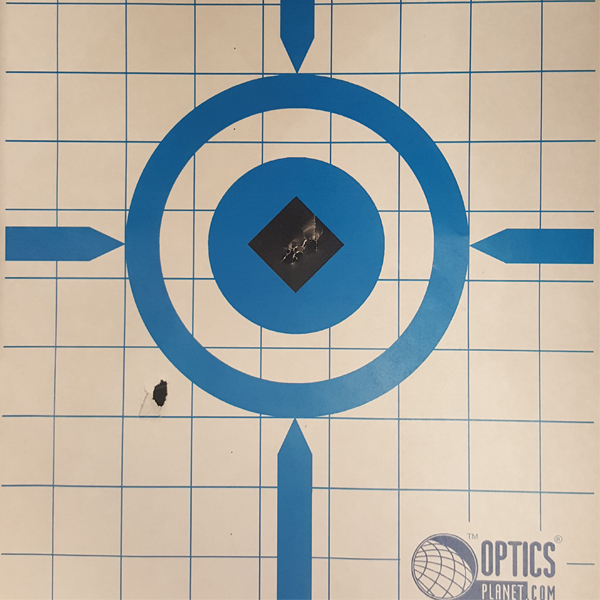How To Set A Rifle Scope At 25 Yards
Sighting in a telescopic is the process that is necessary to get a rifle and its optic tuned for accuracy. In this article, nosotros cover how to sight in a telescopic, how to conform a rifle telescopic, sighting in at 25 yards, and how to nada a scope.
Zeroing a telescopic is the act of aligning your POA ("point of aim", what you're aiming at) and your POI ("point of impact", where the bullet fired out of your gun is hit) at a specific altitude. The reason behind adjustment your POA and POI is simple: it allows you to burn down a shot at a known distance and be able to accurately hit where you're aiming at the target, animal, etc.
Whether you're new to firearms or just someone that wants to brush upward on the correct mode to punch in your scope or cerise dot sight, nosotros're going to requite you lot the ins and outs of zeroing an optic to your rifle.
*Please brand certain you always follow the 4 rules of firearms safety, especially when using this guide.
Stride one: Mount Your Telescopic
While sighting in a rifle is not overly difficult or complicated, the accurateness of your firearm and scope combination all comes downwardly to how well yous installed your telescopic to the mount and attached information technology to the rifle. Information technology is STRONGLY recommended to perform a quality mountain job on your optic. If you want to double-check to make certain your scope is installed correctly, take a look at our in-depth How to Mountain a Riflescope video here.
Along with how well you mount the scope to your firearm, purchasing a subpar optic volition also exit you with an inaccurate burglarize setup should you lot frequently need to do a rifle scope adjustment on your turrets due to elevation and windage.
Step two: Getting On Target

Ok, your scope is mounted correctly, and now it's just you, your rifle, and some ammo at the range. If this is the first time that you're firing the burglarize it's all-time to accept 10-20 minutes and dry burn your gun to go a skillful feel for the trigger. The last thing you want to practice is mistake a poor trigger pull for a shot then make a scope adjustment off of that.
Once you've gotten comfortable with the trigger on your rifle, it'due south time to fix a distance to zip your scope. Most riflescope manufacturers suggest zeroing at 100 yards so that's what you're going to do.
*If you prefer to do a 25-yard zero, run into the formula farther down in this article, but it won't change the steps nosotros're covering.
Have a target like the 1 seen in this guide and position it at the 100-yard line. To go consequent and accurate shots, a rifle demote rest or sandbags are a must. It is also highly beneficial to have a spotting scope next to you focused on the zeroing targets you're shooting at.
While aimed at the dead center of our target, take ii controlled shots. By and large, these first shots are going to be somewhere in this lower left area.
Step 3A: Zeroing A Telescopic Lonely

If y'all're zeroing alone, this is the all-time way to get your scope dialed in. If yous have a friend with you, skip to Step 3B.
Bold that you have a spotting scope or can meet the bullet holes that yous just punched in your 100-yard target, you need to figure out how many squares upwardly/downwards and left/correct you're off from the bullseye. Luckily the target we gave you at the get-go of this guide makes that relatively uncomplicated considering every square is exactly 1 inch.
A vast majority of riflescopes are adjusted in Minutes of Adjustment (MOA) increments, so y'all need to figure out what value each click on your turret is. On most riflescopes, including the one pictured in this guide, each click is equivalent to ane/4 MOA at 100 yards.
Since the start ii shots are low and left of the middle of the target, we know that we need to creepo the windage and elevation knobs where we want the bullet to affect. Based on this target, you tin can run across we need to become ii squares to the right and two squares up. Because every square represents 1 inch, and 1 inch is more than or less equal to 1 MOA at 100 yards, if we were shooting at 100 yards it would be uncomplicated. Eight clicks to the right on the windage knob (1 click=1/4 inch at 100, 4 clicks = 1 inch, we are 2 inches off the centerline = eight clicks) and eight clicks up on the elevation knob.
After you've washed this, relax, get settled and have two more well-placed shots at the heart of the target. You should exist right on. If not, turn the appropriate windage or superlative knob in the management and click adjustment for where y'all need your shots to hit.

From there, nosotros're going to want to set this as the new "zero" on the telescopic. Depending on the particular scope, this might require you to loosen a screw on top of the turrets or pull out on the knob and align the "0" with the line at the rear of the turret. E'er refer to the manual for your riflescope on how to exercise this correctly. At this bespeak, you tin screw on your turret caps if you have capped turrets.
We too strongly suggest taking several shots at a clean target for that extra confidence that your scope is set up perfectly.
*If y'all're going to exist sighting in at 25 yards for 100-yard nothing, refer to the easy-to-employ formulas below to calculate MOA aligning at your chosen distance.
How to arrange scope:
- (Distance to target in yards) / (100) = inches per MOA at that altitude
- (Number of inches of adjustment needed) / (inches per MOA at that altitude) = MOA adjustment
- (Number of clicks per 1 MOA on scope) ten (MOA adjustment) = adjustment in clicks on telescopic
- For example, sighting in a rifle at 25 yards for 100 yards:
- 25/100 = 0.25 inches per MOA
- 0.25/25 = 6.25 MOA aligning
- (Number of clicks per 1 MOA on scope) x half dozen.25 = adjustment in clicks
Stride 3B: Zeroing A Scope With A Spotting Partner

If you're lucky enough to have someone with y'all at the range when dialing in your scope, information technology'll save you time and a few extra rounds of ammo, too.
Now yous've already taken two shots on paper at 100 yards, and they've punched one big pigsty nigh 2 squares low and 2 squares left of the heart of the target. Normally we'd revert to Pace 2 in this guide and through a serial of elementary math equations figure out how many clicks to turn the turrets, but y'all have an extra set of hands that are going to make it a lot easier.
Making sure to really hunker downwardly on the burglarize to prevent move, aim at the dead center of the target. While doing so, you're going to have your friend delicately move the turrets. In our case, the bullet holes are roughly 2 boxes down and 2 boxes to the left, so you're going to have your friend turn the turrets in the management that you demand the next shots to go. Keeping the rifle extremely steady and aimed at the heart, have them get-go clicking right on the windage knob until your crosshair aligns vertically with your bullet holes. Afterwards that have them click the summit knob upwardly until your crosshair lines upwards horizontally with the bullets' holes. Now aim at the center of the target once again, burn down a shot and you should be right on the money.
From at that place, we're going to desire to set this as the new "zero" on the scope. Depending on the scope, this might crave you to loosen a screw on pinnacle of the turrets or pull out on the knob and align the "0" with the line at the rear of the turret. Always refer to the manual for your riflescope on how to do this correctly. At this point, you can screw on your turret caps if you have capped turrets.
Simply like dialing in when you're alone, nosotros still strongly propose taking several shots at a make clean target for that actress conviction that your scope is fix up perfectly.
Step 4: Zeroing Ballistics Beyond 100 Yards

You lot're not out of the woods nonetheless!
Okay great, you're dead on at 100 yards simply do you lot plan to only shoot at 100 yards? Depending on what riflescope y'all're using, it might characteristic a BDC-type reticle with bullet drop holdover stadia marks for making shots at varied extended distances. Most of the master riflescope manufacturers like Vortex, Leupold, Nikon, etc. have some sort of ballistic reckoner to help you figure exactly what your round does, not only at different distances but during less-than-optimal weather atmospheric condition likewise.
If that isn't enough for you, at that place are quite a few ballistic software applications out there that are easy to use. Personally, I'm a huge fan of Strelok+. It's a low-price app for your telephone that will give y'all an image of your exact reticle, a slew of targets, and evidence you where to aim if you lot want to hit that target at a specific distance. Information technology'southward almost as close to being idiot-proof as it gets and the reason information technology's on my telephone.
It doesn't matter which route you decide to go to figure out the ballistics of your rifle and scope setup, the betoken is that you lot do it.
Shop Featured Optics Brands
Source: https://www.opticsplanet.com/howto/how-to-how-to-zero-a-riflescope.html

0 Response to "How To Set A Rifle Scope At 25 Yards"
Post a Comment